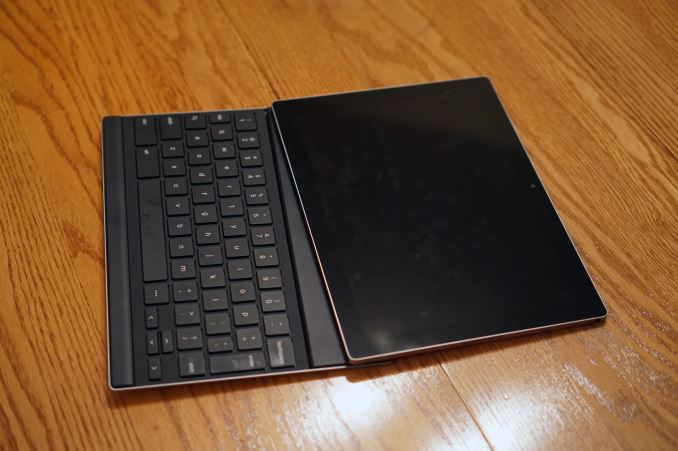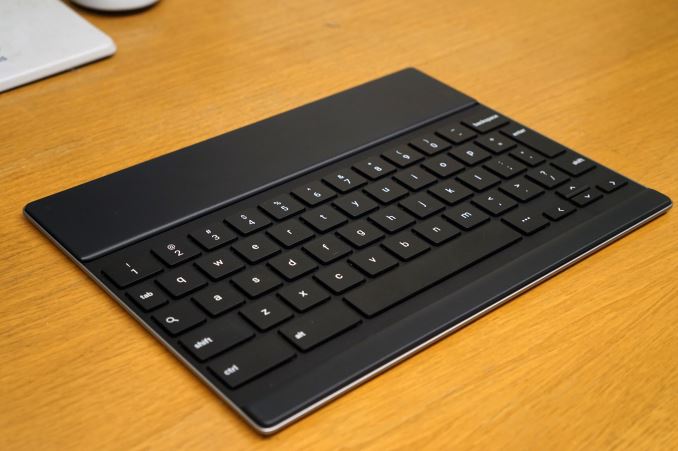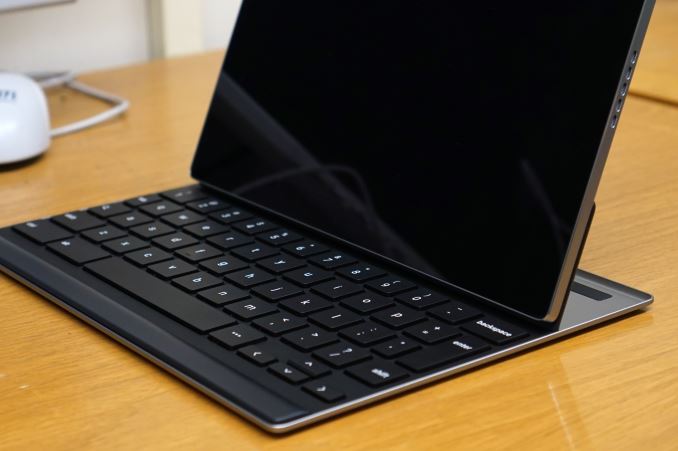The Google Pixel C Review
by Brandon Chester & Joshua Ho on January 25, 2016 8:00 AM ESTKeyboard
Part of the Pixel C’s appeal comes from the keyboard accessory. It isn’t included with the tablet itself, but this is true of most keyboards on tablets so it’s not as if the Pixel C is behind the competition in this regard. At $149 the keyboard is also well priced for one made out of machined aluminum, with full key travel and the Pixel C’s signature magnetic hinge.
Before talking about the keyboard itself, it’s probably a good idea to go over how that magnetic hinge works. The back of the Pixel C’s keyboard is a large aluminum flap with an equally large magnet on top. The best way you could describe the system is that this flap is connected to a very stiff hinge, which allows the flap to go to almost any angle up to about 85 degrees from the horizontal. The tablet has magnets embedded in its back which allow it to connect to this flap, and there’s enough strength in the connection to keep the tablet connected, as well as enough strength holding up the flap to prevent the mass of the tablet from causing it to start shifting back to a horizontal position. This system allows Google to give very fine angle adjustments without having to embed a kickstand in the Pixel C, and it’s quite a clever solution to the problem.
Of course, a unique keyboard solution does come with unique challenges. Obviously you end up with less space for the keyboard because the entire piece has to be the same size as the tablet, with a significant portion being dedicated to the magnetic flap. This is just an inherent result of the design, and while one could say it’s a waste, I would argue that the benefits of the system far outweigh this apparent downside.
The only real problem is training yourself to use the system correctly. When you put the tablet and keyboard together, you need to orient it with the tablet’s LED light bar on the same side as the keyboard’s space bar, or the keyboard won’t be able to charge using the Pixel C’s inductive charging. Unfortunately, this leads to some moments of confusion as you try to orient the tablet correctly after removing it. To split apart the keyboard and tablet Google recommends that you slide the two apart by pushing on the shorter sides of the keyboard and tablet. The first issue with this approach is that anything trapped between the keyboard and display is liable to absolutely ruin the glass, which has happened to my unit around some corners of the display.
The other issue is that once the two are separated you then need to remember to flip the tablet upward to put it in the right position to connect with the keyboard. While this seems like a natural motion, I find myself doing it incorrectly because even after sliding the two sections apart there’s still a magnetic attraction between the long edges of the tablet and keyboard, which causes me to favor rotating the tablet in order to separate them. In this case, the tablet ends up being upside down, and so you need to look at it and orient it such that the front-facing camera is on the top bezel before attaching it to the keyboard.
While some may feel that my issues working out the connection and disconnection of the keyboard are simply user error, it is worth noting that Google includes an enormous instruction sheet along with the Pixel C, and so confusion among users is clearly expected to some extent. I’ve gotten better at setting up the tablet in keyboard mode quickly, but it’s still not an action that has become a second nature to me.
Once you’ve set up the keyboard, you may notice something very familiar about it if you’ve had any experience with Google’s other Pixel products. The core part of the keyboard uses the exact same key size, pitch, and travel distance as the Chromebook Pixel. Google has shrunken the keys around the edges in order to match the keyboard to the Pixel C’s 10.2” display, but I haven’t found it to be much of a problem in use. On the contrary, I think the feel of the keyboard is great. The keys have a good tactile response, and the spacing is comfortable. In my eyes it definitely surpasses the iPad Pro’s Smart Keyboard by a large margin, although I’m not sure how well it compares to Microsoft’s Surface Type Cover.
Unfortunately, the keyboard becomes another area where the apparent mid-development switch to Android causes numerous issues. On the design side, you’ll notice that the keyboard follows the Chromebook Pixel in replacing the caps lock key with a search button. Right off the bat, I noticed a glaring issue with the implementation of this key. You can press search to open a search box anywhere, but I cannot find any way to close the search box if you open it by accident. If you open the search field you need to tap on the display to close it. There needs to be forgiveness in the design, either by making a backspace press when the field is empty close it, or by allowing you to close it by tapping search again with an empty field.
Android itself just doesn’t work very well with keyboards either. In fact, this implementation isn’t near as good as what I saw on the Dell Venue 10, and I didn’t think that provided a very good experience either. The big problem stems from the fact that Google hasn’t included proper navigation keys, which is more evidence that this device wasn’t ever meant to run Android in the first place. The omission of keys to trigger the standard home, back, and recent apps buttons is simply unacceptable. Google does have a help page online which lets you know the cryptic multiple key combos that perform these actions, but I don’t understand why a simple action like home needs to be activated by pressing search and enter, which are on entirely different sides of the keyboard. The same is true of back, which is search + backspace. Thankfully, Google does offer standard shortcuts in many of their apps, but the lack of navigational buttons on the keyboard is a big problem.
Ultimately, the Pixel C’s keyboard is a great piece of hardware, but Android doesn’t work very well with keyboards, and this keyboard in particular is ill suited to Android on top of that. Google has a very novel hinge implementation, and the inductive charging takes away the need to charge the keyboard, but many of the processes need to be streamlined and just generally made easier for the user to understand and get used to quickly. The tablet really needs to be able to attach onto and charge the keyboard without requiring a specific orientation, and the keyboard needs proper Android navigation shortcuts on top of Android simply needing much better keyboard support and applications to take advantage of one. I would love to see the ideas behind the Pixel C’s keyboard and hinge make it into keyboards from other manufacturers in the future, as well as future Android tablets that better deliver on promises of productivity abilities.














122 Comments
View All Comments
ImSpartacus - Wednesday, January 27, 2016 - link
You're paying for something that "just works". You'd be surprised at how attractive that is for a lot of people that are simply incapable of using modern tech.So you can either stick your fingers in your ears and demand that everyone spend years of their life becoming experts in modern tech, or you can realize that there's some money to be made. Apple is in the business of making money.
Alexey291 - Saturday, January 30, 2016 - link
No offence to your and your expertness. But do you honestly think that it takes "a few years" to become an expert of playing with touchscreen devices?Oh boy...
jbelkin - Monday, January 25, 2016 - link
Well, not ignorant, just an economy that only supports 9% of buyers being able to afford the stnadard bearer.Vlad_Da_Great - Tuesday, January 26, 2016 - link
@jbelkin. EU are not as shallow and easy to manipulate as their USA counterparts. Also, biggest % of iPhone purchases in USA are done from people over 60y old. If you look around the globe the second biggest country with huge engineering population (India) has no interest in the iPhone.Asians on the other side love magic, that is what APPL is good of selling.
vanilla_gorilla - Tuesday, January 26, 2016 - link
That's mostly related to income. The vast majority of those people would much prefer an Apple device if they could afford it. Most Android devices are incredible cheap devices.the_comment_guy - Tuesday, January 26, 2016 - link
What are you talking about? Apple hasn't been ableto open stores in India due to their laws requiring 30% of their components to be sourced from small to medium enterprises: that's why they've barely made a dent in the Indian phone market. Despite this, Apple's sales in India have been increasing every year. If India relaxes its backwards laws, and Apple is allowed to open their own stores, Apple sales will explode.Alexey291 - Saturday, January 30, 2016 - link
Sure the sales have grown in india. Shame about the sales in the rest of the world.Essentially last quarter's sales have been propped up by the Chinese and Indian sales growth. The rest of the world however...
akdj - Thursday, February 4, 2016 - link
Rest of the world? As in North, South America and a dozen European countries? Apple's BLOWN their OWN records out of the water with iOS device sales. iPads are down ...unfortunately for Apple, they're built too well! Seriously, as I've owned each iPad ...we use them with our business and both original and iPad 2s are still BOTH working & battery life on the first iPad continues beating a dozen hours watching movies. Eight browsing or a good 25-30 listening to music, screen off!My iPad '2' purchased on launch day and the kids use it all the time. No issues ...they're replied amid don't die. Apple is continuing support for older devices. Kicking their own selves in the sack! Or ...maybe not.
While geeks like me justify with my job, personal business and personal 'wants' the purchase of each new iPad that drops, and because of each gen's phenomenal updates. iPad 3 aside, which I owned until 4 dropped - iPad 3 left on Craigslist the following day with its updated performance so obvious. The 'new' iPad 3, IMHO, is the only anomaly to the updates and performance increases, display/resolution updates, shaving weight, maintaining battery life and dramatically boosting its 'guts', sensors, display accuracy and smaller but significant user bonuses like the A/G display stack and their lamination & out of factory calibration ....make each iPad, in my line of work, play & education priceless! Original to iPad 2, the difference was/is obvious. 2-->3, 'Retina' on the iPad, a complete game changer. Oops, same engine as the iPad 2, 4 times the resolution, drop the 4 with its Apple designed SoC monster A8X --- exponentially bettering the iPad w/Retina experience!
While somewhat less Ferrari, more Subaru ...Air 1 is today a fantastic tablet (I've both Air 1 & 2). It's slower than its younger sibling but its sporting the first 64bit processor in a tablet and mine continues to get a lot usage. My Air 2, there's nothing on the market comparable. Not w/the App Store and its million optimized, all inclusive app/software accompanying options to aggregate and integrate with the home Mac, studio Macs or your phone/tab with Handoff. The continuity Apple's built into iOS and OS X as well as supporting older devices with both desk OS's, it's no wonder folks aren't replacing them as quickly as a phone! They're still selling a quarter more than the rest of the field does in a year! When you take the <$149 tablet choices off the table, iPad in its slump is outselling the entire industry 2-1 quarter vs. year! It's a top 100 in the Forbes 500 business itself! That's crazy IMHO. But the addition of iPad Pro changes things. Doubling the RAM on the iPhone 6s & iPad Air 2 was obvious in use, day to day ...it was just a LOT quicker at everything than my Air 1. They've now doubled to 4GB in iPP and as an owner for 3 months, I've never been happier with an iPad. The iPad A2 still ROCKS! I use it daily and it's as robust and reliable as any predecessor, just a helluva lot faster and finally now, finally being targeted by developers to take advantage of the hardware...as older products are phased out
Which left me curious about Josh's final comment/words
'Overall, I’m not even sure this measures up to the iPad Air 2 which is well over a year old by this point. I cannot in good conscience recommend anyone buy this tablet until the touch screen issues and generally poor performance has been resolved, and even then that recommendation would be to a limited group of people solely interested in a touch-only Android tablet.A
I read the review a second time all the way through. I went back and read the Air 2 review as well. While a couple of benchmarks seem to have parity or even exceed A2's --- the display performance, also beating A2, it's close in your measurements but EVERY other word strongly suggests not just an inferior experience in comparison (Pixel v A2), but performance destroyed by my iPad 4! Janky, unable to maintain connection, freezes and crashes and.... I can go on, it's not necessary though. Just seems to very much understate iPad A2's performance and without reading the rest, complete overstatement of the 'experience' of PixC as a couple of benches close, neck & neck, means absolutely nothing when it comes down to the user's overall experience. My iPad 2 seems to be a better comparison!
Yikes
lilmoe - Monday, January 25, 2016 - link
Nice ignorant comment bro. Way to go.id4andrei - Monday, January 25, 2016 - link
Hardware has nothing to do with Android's problem. Dev support for tablet operation in Android is lacking. Simple.